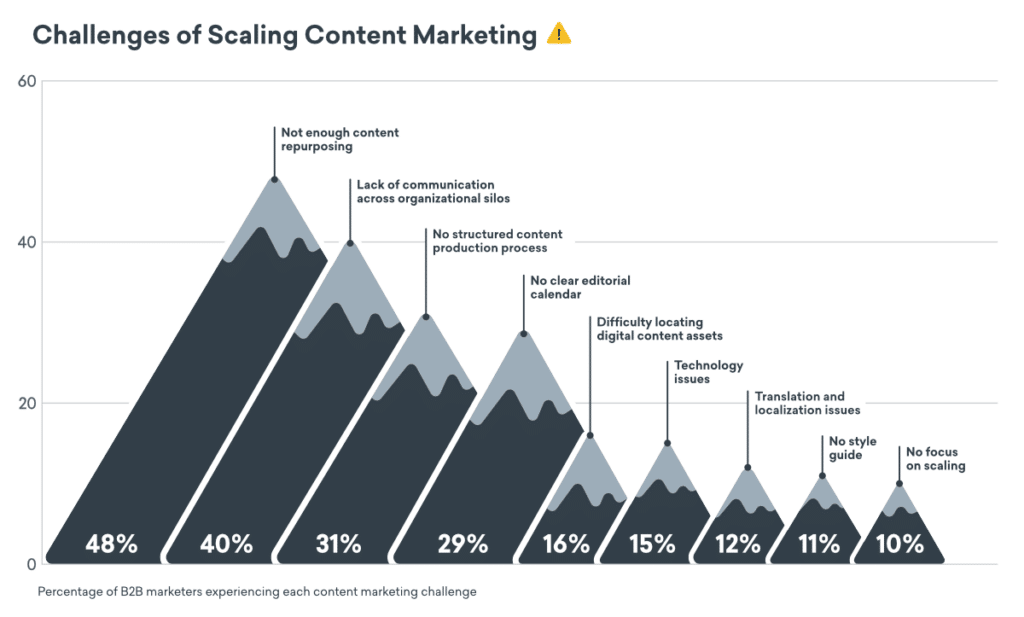Content is the foundation of any technical marketing strategy. Then, to make the most of your content marketing efforts, you must scale your content production.
Scaling involves increasing your content’s quantity and frequency of releasing new material while promoting that content for readers to find.
While posting one helpful article to your company blog might draw some initial interest and a trickle of ongoing traffic from search engines, it can’t support your company’s growth in the long term. Writing a wide variety of topics helps ensure you cover all keywords relevant to your organization and all stages of your marketing funnel (not to mention catering to everyone from beginners to seasoned professionals to decision-makers). Plus, regularly posting content helps sustain interest from readers and search engines even as the initial spike in one article’s readership drops.
Your audience seeks trusted sources they know will have the information they need. Scaling your content production helps establish your organization as an authority in your field.
That said, scaling your content can be challenging. We’ll help you focus on what to do to scale your technical content effectively despite these universal challenges.
Top Barriers to Scaling Content Production
The challenges of scaling content production run deeper than simply finding enough time in a busy workday. The Content Marketing Institute explored typical challenges in its content marketing trends survey.
Close to half (48 percent) of B2B marketers note that insufficient content repurposing is a significant marketing challenge. Once they spend hours researching and writing an article, they may post it to the company blog, hoping someone will find it in a search. Then, they rinse and repeat by investing more hours in the second article.
Given the time and resources, savvy B2B marketers make the most of that initial article by repurposing it. A long-form whitepaper may become a smaller article focusing on a specific section’s insights, capturing a broader audience. Maybe some bite-sized tips find their way to your company’s social media accounts for even more promotion, or survey results become a shareable infographic that makes its way around the Internet.
Another challenge 40 percent of B2B marketers face is a lack of communication across organizational silos. Maybe someone in sales hears a compelling story about how your product revolutionized a client’s approach to application development and saved them hundreds of thousands of dollars. Or, perhaps a developer adds a fantastic new feature to your product. If the marketing department doesn’t hear these enticing stories, they can’t tell everyone else about them, either.
The lack of a structured content production process hinders 31 percent of B2B marketers, and not having an editorial calendar with clear deadlines inhibits 29 percent. Without a plan and someone to carry it out, regularly writing new content is challenging — let alone ensuring you repurpose it as much as possible.
Difficulty locating digital content assets affects 16 percent of B2B marketers, 15 percent face technology issues, 12 percent experience translation and localization issues, and the lack of a style guide impacts 11 percent. Finally, 10 percent of B2B marketers note that scaling isn’t a current focus.

Although these challenges limit your ability to scale, we’ll help you overcome these concerns with tips to boost your technical content marketing efforts.
Develop a Structured Content Production Process
Organizations often take a haphazard approach to content production, squeezing it in when someone finally has some time. Yet, a route like this hinders scalability.
Without a structured content production process, nobody is responsible for ensuring it gets done (and the organization doesn’t guarantee that person has the time to do it). The content producers might not hear about new initiatives and exciting stories across the organization. They might not be able to connect with the organization’s subject matter experts or get access to other resources for the information needed to write a piece. Two team members may even duplicate work.
In the end, effective content production might simply not happen.
Establishing efficient content production workflows and processes helps you overcome this challenge. When you standardize the process, you have a better idea of the time and resources needed to produce content and can allocate those resources appropriately. Then, the social media team knows what they need to do to promote the content and where. Plus, other departments understand how to pitch in by providing resources and sharing content with their clients.
A structured content production process ensures your organization handles every piece of content consistently.
To start, determine your workflow for each content type — for example, an article versus a video versus a whitepaper. Then, specify the tasks required, from keyword research and planning to publishing and gathering analytics. Determine how long each step should take and assign someone responsible for each task.
Automation enhances your productivity, too. Set up workflow software to alert everyone when a task is due and publish it when it’s ready to go. This automation handles administrative tasks while keeping everyone on track, enabling your team to create more content in less time.
Implement an Effective Editorial Calendar
An editorial calendar is critical as you scale your content marketing efforts. It helps manage and streamline content schedules, ensuring everything is ready on time and everyone knows what to expect and when to expect it.
You can house this plan in a simple spreadsheet or an automated tool. Then, detail each piece’s tasks and due dates. Team members gain visibility into the project and collaborate more effectively when they know what’s on the horizon. Plus, you can plan for special events and product releases and then work evergreen content into the spaces between.
A calendar helps ensure you cover all business objectives with various content topics and types. You’ll produce content regularly, keeping your momentum going as you scale your technical marketing efforts.
As you create your editorial calendar, consider your goals, target audience, and available resources. Then, adjust as needed to scale as more resources become available.
Overcome Project Management Obstacles in Content Production
When scaling your content production, you may face project management challenges. You must allocate resources, manage deadlines, and coordinate the team to get it all done.
Agile methodologies help break this enormous initiative down into bite-sized tasks. Then, a digital project management platform promotes communication, letting everyone know what task they need to do, when they need to do it, and the status of the previous stage. Doing so ensures the entire team can coordinate to write and distribute the content on time.
Be prepared to adjust your original goals if needed, such as if you gain or lose resources.
Navigate Technology Integration and Use
Technology assists in scaling your content production. At the elementary end of the process, a standard word processor helps check your content for spelling and grammar errors (specialized grammar tools help, too). Specialized tools and artificial intelligence (AI) writing assistants, such as Grammarly, can enhance your word processor’s capabilities and help to streamline the writing process.
Then, digital collaboration tools like Asana or Trello help organize your content production project. Your team can visualize the organization’s goals and the steps involved in producing the content you need. Choose the tool that best matches your team’s working style while fitting into your budget.
When the content is ready, a content management system (CMS) helps publish the piece on your website or social media, ready for readers to enjoy. CMS tools differ in where they can publish your content, so ensure you choose the right one for your needs. Your CMS will also play a role throughout the content’s lifecycle, providing a platform for managing, editing, or deleting existing content.
AI is no substitution for a thoughtful article, yet some AI-based tools help you plan your content’s structure and unearth hidden gems of information. Provide your team members with guidelines for its use to align with your company’s policies and goals.
Your team members might also need a keyword research tool, like the ones found in Ahrefs or Semrush, to plan your content and ensure each piece has the keywords it needs to attract organic search traffic.
Don’t forget that written content also requires a graphical component. Your graphic designer needs a straightforward graphics tool like Canva or more advanced software to produce a header image and infographics.
Your team may need video editing, live streaming, podcasting, and transcription software, too, if you’re focusing on that type of content. A content repurposing or social media content generation tool can help you quickly adjust a piece to a new format as well.
Again, consider your team’s specific needs and budget when selecting content production tools.
Tackle Translation and Localization Issues
Scaling your content might involve translating and localizing it to reach a broader, international audience. Yet, it can be challenging to reach your new audience effectively.
First, there are nuances within a language. Although most customers speak English in the United Kingdom and the United States, some spellings differ (think flavour versus flavor). Plus, words may have different meanings in two areas (think the classic automotive example of the adventurous-sounding Nova that sounds like “no go” in Spanish.) Then, there are various languages within a country, like Spanish populations in the Southwest United States and the minority Romansh speakers of Switzerland.
To scale globally, translate your content into the languages of the desired regions while considering cultural nuances. This approach involves more than relying on a team member’s successful completion of Spanish 101. You may need to partner with regional coworkers for editing help or outsource your translations to another firm. That way, you avoid sounding like a teen wrote your blog post while dodging cultural faux pas.
This approach lets you repurpose existing content to scale globally.
Master Editorial Processes and Fact-Checking
It’s easy to make mistakes when ramping up your content production. Spelling and grammar errors and, worse, erroneous facts can make any organization look unprofessional. Although most readers understand the occasional mistake happens, too many errors build the reputation that your company doesn’t know what it’s talking about, casting doubt on your otherwise superior product’s quality.
The best way to avoid errors is to have multiple people review a document before publishing. A fresh perspective can catch a turn of phrase that doesn’t quite sound right. A subject matter expert, otherwise too busy to write content, can take a quick look to ensure the piece sounds factual.
To build and maintain the editorial rigor you need to uphold your organization’s reputation, you can implement a dedicated editorial team. Sometimes, you may assign one editor to review all writing. Or, you can switch an editor role between two writers.
You can implement a fact-checking protocol, too. Create a task for a writer or editor to double-check information. Dig into the fine details, such as how specific products or companies spell and capitalize their names. Watch for statistics or claims that need a reference. Consider assigning a task to a subject matter expert or technical team member, if available, to read the piece before publication.
With these requirements in place, your team can be sure to publish polished, factually correct content even as your publishing volume scales up.
Implement a Style Guide
Some spelling and grammar rules are universal, while others vary from organization to organization. A style guide outlines spelling and grammar, language, tone, branding, and formatting guidelines specific to your organization.
With this style guide in place, your content producers and others across your organization know your company’s preferences. They can ensure all content, from the website to blog posts to sales materials, is consistent, reducing customer confusion and ensuring a professional image.
For example, your style guide might specify your product’s name as “BestWidget” instead of “Best Widget.” It might also tell writers to avoid insensitive or non-inclusive words or tired phrases like “thinking outside the box.” It can let writers know to use a more formal tone for reports and a more approachable voice for social media posts.
You don’t have to start from scratch. Let your team know they can reference a specific style guide, like Chicago or APA, for most questions. Then, think of the specifics relevant to your organization and list them in a location accessible to the entire team or company.
Having a style guide in place not only promotes consistency across everything you publish: It also assists with scalability. Questions that might hold up the editorial process can be solved with a quick reference to the style guide, potentially shaving hours or days off the process.
Next Steps
Scaling content involves challenges beyond finding time and accessing resources. Failing to repurpose content, lack of communication, lack of a structured process and editorial calendar, difficulty locating assets, technology issues, translation and localization issues, the lack of a style guide, and a lack of focus on content marketing can all hinder your organization’s ability to reap the benefits of scaling technical content production.
Yet, when you standardize your processes, employ automation, implement an editorial calendar, use an agile approach and digital tools to manage your content production project, embrace digital tools, consider translation and localization, implement editorial and fact-checking processes, and refer to your custom style guide, scaling your content becomes straightforward. Your team knows how to produce each piece and regularly pump out content to boost your engagement.
That said, your busy marketing team may not have the workforce or specialized expertise to keep up with your ambitious technical content marketing goals. Engaging a third-party agency like ContentLab can help you scale your content. You’ll benefit from an entire team of strategists, writers, editors, subject matter experts, and others to ensure your technical content is factual and compelling — and available at scale.
Looking for a partner to help scale your content production? Reach out to ContentLab today.





